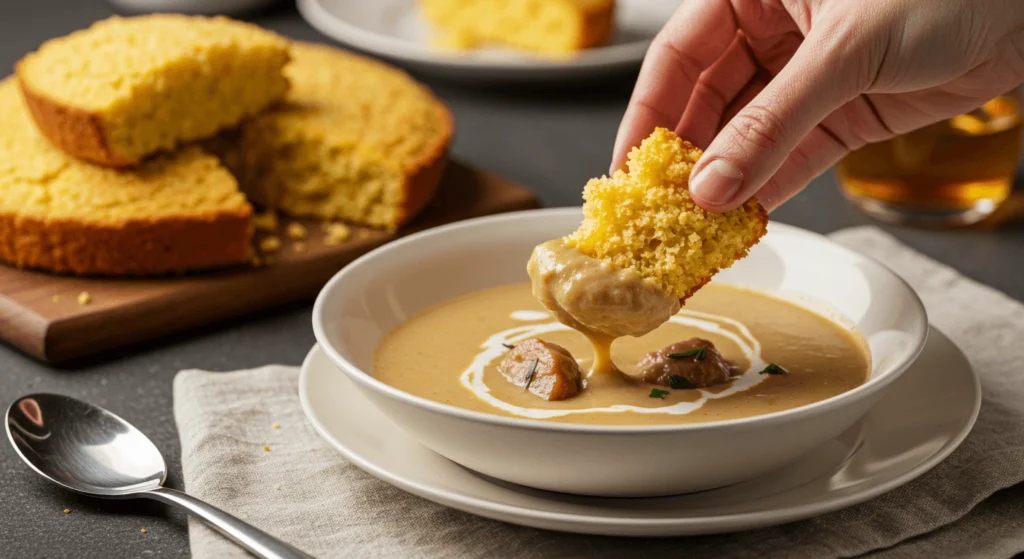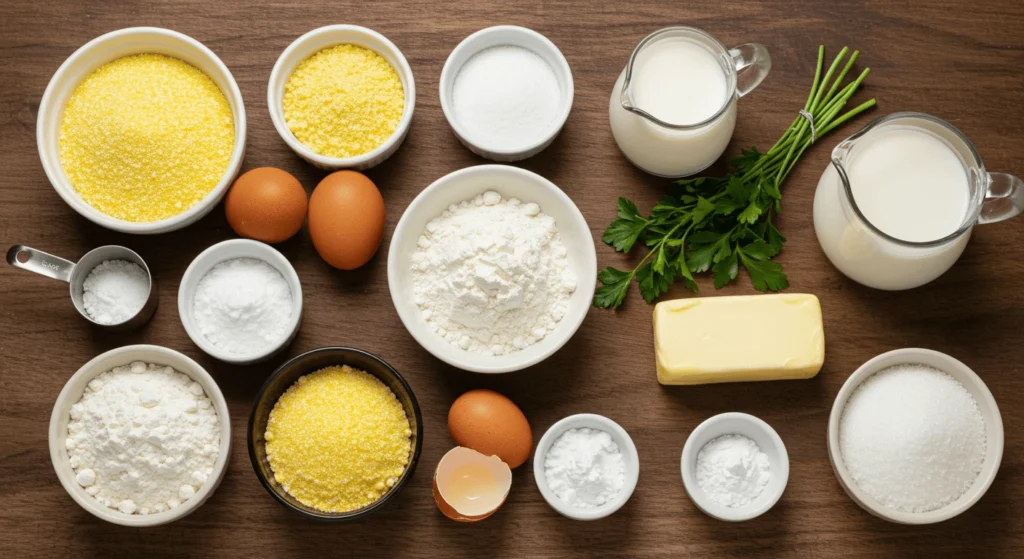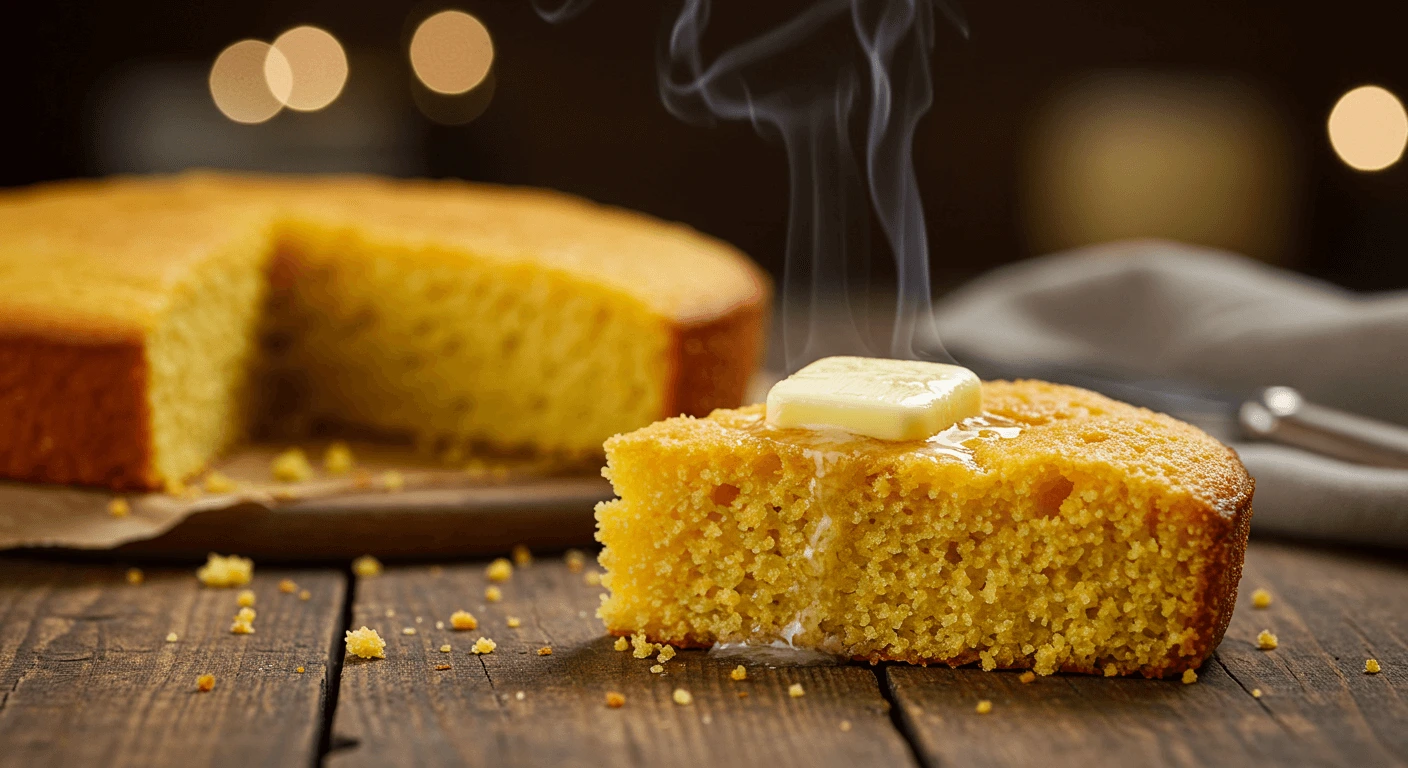Introduction
Few dishes capture the heart and soul of Southern cuisine quite like a classic Southern cornbread recipe. This golden, crumbly, and irresistibly flavorful bread has been a staple on dinner tables for generations, offering comfort in every bite. Whether served alongside a steaming bowl of collard greens, a hearty stew, or simply enjoyed on its own with a smear of butter, cornbread has a way of making any meal feel special.
The history of the Southern cornbread recipe is as rich as its flavor, tracing back to the early settlers who adapted indigenous ingredients like cornmeal into their diets. Over time, this simple dish evolved into a cherished tradition, with families passing down their secrets for achieving the perfect blend of crispy crust and tender interior.

So, what makes this the best Southern cornbread recipe you’ll ever taste? It’s all in the balance—using buttermilk for tangy moistness, a hot cast iron skillet for that signature crust, and just the right touch of butter to elevate every bite. In this post, we’ll walk you through everything you need to know to master this iconic dish and bring a little slice of Southern comfort to your kitchen.
Table of Contents
The Essential Ingredients for Perfect Southern Cornbread
The foundation of any great Southern cornbread recipe lies in its simple yet essential ingredients. With just the right balance, these components work together to create cornbread that’s golden, fluffy, and downright irresistible. Here’s what you’ll need:
Ingredients:
- 1 cup of medium-grind cornmeal
- 1 cup of all-purpose flour
- 1 ½ teaspoons of baking powder
- ½ teaspoon of baking soda
- 1 teaspoon of salt
- 1 ¼ cups of buttermilk
- 2 large eggs
- ¼ cup of melted butter (plus 1 tablespoon for greasing the skillet)
- Optional: 2 tablespoons of sugar (for those who prefer a slightly sweeter cornbread)

Cornmeal:
Cornmeal is the star of the show in a classic Southern cornbread recipe. The medium-grind variety strikes the perfect balance—providing just enough grit for texture while still allowing the cornbread to hold together. Avoid overly fine or coarse cornmeal unless you’re adjusting the recipe for a specific texture preference.
Buttermilk:
This tangy, rich liquid is essential in the Southern cornbread recipe for creating a moist and tender crumb. The slight acidity of buttermilk also reacts beautifully with the baking soda, helping the cornbread rise to perfection. If you don’t have buttermilk on hand, you can create a substitute by mixing 1 tablespoon of vinegar or lemon juice with 1 cup of milk.
Baking Powder and Baking Soda:
These leavening agents are the unsung heroes in achieving a light and airy texture. Combined with the buttermilk, they ensure your Southern cornbread recipe rises evenly and develops that perfect crumb.
Butter (or Bacon Drippings):
Melted butter gives the cornbread a rich, creamy undertone, while bacon drippings add a smoky depth of flavor. Either option works wonderfully, but the key is preheating the skillet with the fat to create that irresistible crispy edge that’s iconic in Southern cornbread.
Step-by-Step Guide to Making Southern Cornbread
Crafting the perfect Southern cornbread recipe isn’t just about the ingredients—it’s about how you bring them together. Follow these detailed steps to create cornbread that’s golden, fluffy, and bursting with flavor.
Preheat the Oven and Prepare the Pan
The foundation of a flawless Southern cornbread recipe starts before you even mix the batter. Preheat your oven to 425°F (220°C) and place a well-seasoned cast iron skillet inside. The skillet’s heat ensures the batter sizzles the moment it touches the pan, creating that signature crispy, golden crust that’s iconic in Southern cornbread. If you don’t have a cast iron skillet, a metal baking dish can work, but the results may lack the same rich texture.
As the skillet preheats, melt approximately one tablespoon of butter or bacon drippings, allowing it to coat the bottom and sides of the pan.This step infuses flavor and prevents sticking, making it easier to remove the cornbread once baked.
Mixing the Ingredients
In a spacious mixing bowl, sift together the dry ingredients, ensuring they are thoroughly blended for an even distribution. Stir until evenly distributed. Whisk the buttermilk, eggs, and melted butter together in a separate bowl until they are thoroughly integrated, forming a smooth and uniform mixture.Carefully incorporate the wet ingredients into the dry mixture, stirring with a light hand to preserve the delicate texture of the batter.
The key here is not to overmix. Overworking the batter can result in dense, heavy cornbread instead of the light, fluffy texture a Southern cornbread recipe demands. Having a few lumps in the batter is entirely acceptable and actually contributes to the rustic charm of the cornbread.
Baking the Cornbread
With caution, remove the heated skillet from the oven (ensuring to use oven mitts for safety) and pour the batter into the pan, where it should immediately begin to sizzle.You should hear an immediate sizzle, a sure sign that the crust is forming. Place the skillet back into the oven and bake for 20–25 minutes, or until the top achieves a golden-brown hue and a toothpick inserted into the center comes out clean, signaling the perfect bake.
The golden crust and tender interior are what make this Southern cornbread recipe so beloved. Let it cool slightly before slicing to ensure the perfect texture in every piece.
Optional Add-ins
Want to take your Southern cornbread recipe to the next level? Consider adding:
- Jalapeños for a spicy kick.
- Shredded cheese for a savory twist.
- Sweet corn kernels for extra texture and flavor.
Tips for Achieving the Perfect Texture and Flavor
To master a Southern cornbread recipe, it’s not just about following the steps—it’s about perfecting the details. These tips will help you create cornbread with the ideal balance of moisture, fluffiness, and a golden-brown crust.
Moisture and Fluffiness
A perfectly executed Southern cornbread recipe is distinguished by its remarkable moisture and airy, fluffy texture, embodying the essence of cornbread at its finest. To achieve this, it’s essential to strike the right balance between the dry and wet ingredients. When mixing, avoid adding too much flour or cornmeal. The key is to use the proper ratio of cornmeal to flour for texture, but also to add enough liquid (like buttermilk) to keep the batter moist. The acidity of buttermilk not only enhances flavor but also ensures the cornbread is tender. If you find your batter too dry, add a little more buttermilk or even a touch of milk to loosen it up.Keep in mind that overmixing the batter Can yield a dense, overly firm cornbread; hence, it is crucial to stir gently, incorporating the ingredients only until they are seamlessly combined.
Golden Brown Crust
A crispy, golden crust is one of the best parts of a Southern cornbread recipe, and achieving it requires a few key techniques. Primarily, it is imperative to preheat your cast iron skillet in the oven, as this step is vital for attaining the optimal texture and a perfectly crisped crust. Pouring the batter into a hot skillet allows the batter to sizzle immediately, forming a beautiful crust as it bakes. For an even crispier crust, brush the skillet with melted butter or bacon drippings before adding the batter. If you prefer a more subtle flavor, vegetable oil can also do the trick. Additionally, if you’re baking your cornbread in a different pan, make sure it’s metal to ensure an even, golden crust.
Avoiding Common Mistakes
When it comes to Southern cornbread recipes, there are a few common mistakes that can detract from your cornbread’s texture and flavor. One of the biggest errors is overmixing the batter. Overmixing develops the gluten, leading to a dense and heavy texture. Another mistake is not preheating the pan. If the pan isn’t hot enough when the batter is added, you’ll miss out on that crispy, flavorful crust. Lastly, be sure to use the right type of cornmeal—medium or coarse grind cornmeal is ideal for a traditional Southern cornbread recipe. Finer cornmeal can result in a smoother texture that isn’t quite as authentic.
The Importance of Southern Cornbread in Soul Food and Family Gatherings
Southern cornbread is more than just a beloved recipe—it’s a cornerstone of soul food, deeply woven into the cultural fabric of the South. This simple yet flavorful bread has been passed down through generations, embodying the warmth, hospitality, and resilience that define Southern cuisine.
Soul Food
At its core, soul food is a reflection of African-American history, resilience, and ingenuity, combining African, Native American, and European influences to create dishes full of flavor and meaning. Southern cornbread is no exception. It has roots in the food traditions of enslaved people, who adapted corn, a readily available grain, into their meals. Today, cornbread is a symbol of Southern hospitality and comfort, often gracing the table alongside dishes like fried chicken, collard greens, and black-eyed peas. More than just a side dish, cornbread in soul food is a unifying element, bringing families together around the table to celebrate both everyday meals and significant occasions.
Thanksgiving and Holiday Dinners
No Southern holiday meal is complete without cornbread. It is a key player in Thanksgiving and other festive family gatherings, where it often accompanies rich, flavorful dishes like gumbo, turkey, and ham. Cornbread’s slightly sweet or savory notes complement the bold flavors of Southern holiday favorites, and its texture provides a perfect contrast to the creaminess of dishes like mashed potatoes and macaroni and cheese. Whether it’s baked into a dressing or served as a standalone side, cornbread plays an integral role in making these celebrations feel even more special.
Cornbread Variations
While Southern cornbread may have its traditional forms, the recipe varies widely across regions and personal preferences. In some Southern homes, cornbread is slightly sweeter, often with a dash of sugar or honey, which pairs beautifully with a hearty bowl of chili or a fried chicken dinner. In other regions, cornbread leans more savory, with ingredients like jalapeños or bacon drippings, making it a perfect match for collard greens or stews. These regional variations reflect the diversity of Southern cuisine and how cornbread adapts to complement different flavors, proving its versatility across the South.
Ultimately, Southern cornbread is much more than just food—it’s a symbol of culture, community, and the deep-rooted traditions that continue to shape Southern family gatherings.
How to Store and Reheat Southern Cornbread
Once you’ve crafted the perfect Southern cornbread recipe, you may find yourself with a little leftover. Don’t worry—there are ways to store and reheat cornbread so that it stays as delicious as when it was first baked. Whether you’re saving it for a later meal or want to enjoy it the next day, here are some essential tips to keep your cornbread fresh and flavorful.
Storing Leftovers
To maintain the moisture and flavor of your Southern cornbread recipe after baking, it’s important to store it properly. If you’re planning to eat it within the next day or two, it’s safe to keep the cornbread at room temperature. Simply wrap the cornbread in a clean kitchen towel or place it in an airtight container. This helps prevent it from drying out while preserving its soft texture. However, if you need to store it for a longer period, refrigerate the cornbread in an airtight container or a resealable plastic bag. This will preserve its freshness for a duration of four to five days. Avoid storing it in the fridge uncovered, as it will lose its moisture and flavor.
Reheating Tips
When it comes to reheating Southern cornbread, you want to make sure it stays soft and retains that delightful golden crust.
- Microwave: If you’re in a rush, the microwave works well for reheating individual slices. Place a damp paper towel over the cornbread to trap moisture, and microwave for about 20-30 seconds. Be careful not to overheat, as this can make the cornbread tough.
- Oven: To preserve the texture, reheat cornbread in the oven. Begin by preheating the oven to three hundred and fifty degrees Fahrenheit (one hundred and seventy-five degrees Celsius), then gently wrap the cornbread in aluminum foil. Place it in the oven to bake, allowing it to warm through and regain its soft, moist interior while developing a golden exterior. This will help retain the moisture while restoring its crispiness on the outside.
- Skillet: For a crispy edge, place a slice of cornbread in a hot, lightly buttered skillet over medium heat. Cover with a lid and heat for approximately 3-5 minutes, turning it midway to ensure even warming and a perfectly crisped exterior. This method ensures the cornbread stays moist while adding a nice crunch.
Freezing Cornbread
If you want to store your Southern cornbread recipe for an extended period, freezing is a great option. Start by allowing the cornbread to cool completely. Then, slice it into individual pieces, and wrap each slice tightly in plastic wrap or aluminum foil.Carefully position the wrapped pieces in a resealable freezer bag or an airtight container, ensuring an airtight seal to maintain optimal freshness and prevent freezer burn. Cornbread can be frozen for up to 3 months without sacrificing flavor or texture. When you’re ready to enjoy it, simply thaw it at room temperature or reheat it directly from the freezer using the oven or skillet method mentioned above.
Conclusion
In this post, we’ve explored the essential elements that make a Southern cornbread recipe truly exceptional—whether it’s the use of buttermilk for moisture, the perfect balance of ingredients, or the crispy golden crust that defines this beloved dish. What truly sets this recipe apart is its authenticity and the deep connection it has to Southern cuisine and culture. By following these simple steps, you can bring a taste of the South to your own kitchen, creating a cornbread that’s both flavorful and nostalgic.
We encourage you to try this Southern cornbread recipe for yourself, and don’t be afraid to experiment with variations, whether you prefer a slightly sweeter version or a savory one with ingredients like jalapeños or bacon drippings. The beauty of cornbread lies in its versatility and the endless possibilities for customization.
We’d love to hear about your Southern cornbread recipe adventures! Share your experiences, tips, or any unique twists you’ve added in the comments below. And don’t forget to subscribe for more delightful, authentic recipes that will bring comfort and flavor to your table!

